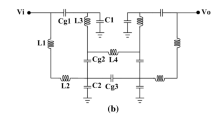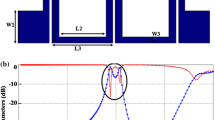Abstract
A WR-3 dual-band bandpass filter based on micromachining fabrication process is presented in this paper. The topological structure of the dual-band filter is formed by a pair of parallel coupled single-band bandpass filter and two T-shaped matching stubs. While each single-band filter is designed by Chebyshev 6-stage inductive obstacle structures. Then the dual-band filter is fabricated and measured. The results show that the dual passbands have about 7 GHz downwards shift than the designing. The rectangle coefficient of the dual passbands is 1.33 and 1.42, respectively. The return loss of the proposed filter is better than 14 and 12 dB while the insertion loss is around 3.6 and 7.1 dB. The whole size of the fabricated filter is about 21 mm × 11 mm × 1.48 mm. It demonstrates a practical way to design, fabricate and measure the dual-band filter working in terahertz range with good rectangle coefficient.












Similar content being viewed by others
References
Chen Xu, Fan Wen-Hui (2015) A multiband THz bandpass filter based on multiple-resonance excitation of a composite metamaterial. Mater Res Express 2(5):055801
Chen Z et al (2013) WR-28 band micromachined rectangular waveguide filter. J Infrared Millim Terahertz Waves 34(12):847–855
Duan J et al (2015) Microfabrication of a dual-mode rectangular waveguide filter. Microsyst Technol 1–6
Fitch Michael J, Osiander Robert (2004) Terahertz waves for communications and sensing. Johns Hopkins APL Tech Dig 25(4):348–355
Leal-Sevillano CA et al (2013) Silicon micromachined canonical-plane and-plane bandpass filters at the Terahertz band. Microw Wirel Compon Lett IEEE 23(6):288–290
Leong KM et al (2012) WR1.5 silicon micromachined waveguide components and active circuit integration methodology. IEEE Trans Microw Theory Tech 60(4):998–1005
Li G-H et al (2014) Novel high-selectivity dual-band substrate integrated waveguide filter with multi-transmission zeros. Progress Electromagn Res Lett 47:7–12
Liu S et al (2015) Silicon micromachined waveguide quadrature-hybrid coupler at terahertz frequency band. J Infrared Millim Terahertz Waves 36(8):709–719
Naeem U et al (2014) A dual-band bandpass filter with widely separated passbands. IEEE Trans Microw Theory Tech 62(3):450–456
Shang X et al (2012) WR-3 band waveguides and filters fabricated using SU8 photoresist micromachining technology. IEEE Trans on Terahertz Sci Technol 2(6):629–637
Wu Bian, Qiu Feng, Lin Lei (2015) Quad-band filter with high skirt selectivity using stub-loaded nested dual-open loop resonators. Electron Lett 51(2):166–168
Yang F et al (2012) Novel multi-band filter design and substrate integrated waveguide filter realization. Microw Symp Digest (MTT), 2012 IEEE MTT-S International. IEEE
Author information
Authors and Affiliations
Corresponding author
Additional information
This work was supported by the NSAF Grant (Project number U1430102).
Rights and permissions
About this article
Cite this article
Huang, Y., Li, X., Bao, J. et al. A WR-3 dual-band bandpass filter based on parallel coupling structure. Microsyst Technol 23, 2553–2559 (2017). https://doi.org/10.1007/s00542-016-3054-5
Received:
Accepted:
Published:
Issue Date:
DOI: https://doi.org/10.1007/s00542-016-3054-5




